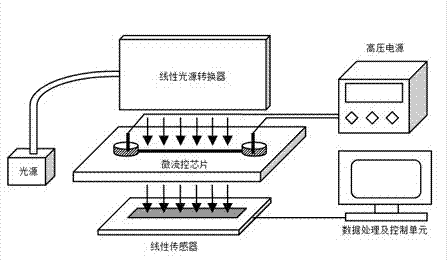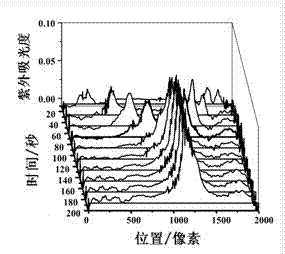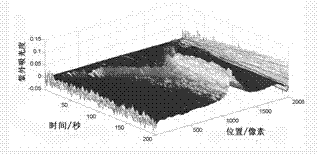Device for detecting microchip electrophoresis by time and space resolution and application thereof
A spatio-temporal resolution and detection chip technology, which is applied in measurement devices, material analysis, material analysis by electromagnetic means, etc., can solve the problems of low temporal resolution and spatial resolution, and no simultaneous temporal and spatial resolution.
- Summary
- Abstract
- Description
- Claims
- Application Information
AI Technical Summary
Problems solved by technology
Method used
Image
Examples
Embodiment 1
[0016] Embodiment 1: Construction of the device
[0017] According to the miniaturization requirements of the chip system, the construction of this detection system avoids using complex optical components (mainly lenses, etc.) as much as possible. The whole system is mainly composed of two parts, namely the detection part and the separation part. The separation part consists of a PDMS chip, a high voltage power supply and platinum electrodes. PDMS chips were fabricated according to literature methods. (Refer to Liu, Z.Lab on a Chip.2008,8,1738-1741) The overall size of the chip is 25mm (width)×50mm (length), and the size of the separation channel at the center is 80μm×80μm×28.7mm (width × height × length), there is a liquid reservoir with a diameter of 3mm at each end of the channel, and a metal slit (slit width: 65 μm) is pasted on the bottom of the chip to avoid the interference of stray light. Platinum electrodes are respectively placed in the reservoir at both ends. The...
Embodiment 2
[0018] Example 2: Establishment of isopoint focusing and space-time resolution electropherogram of pure protein (hemoglobin)
[0019] For the preparation of the PDMS microfluidic chip used for detection and the method of equilibrium flushing, refer to the literature (see: Lab chip, 2008 (8): 1738-1741), the samples used are: 1mg / mL hemoglobin, 2% PVP, 2% ampholyte. Electrolyte (the same below): anolyte is 100mmol / L phosphoric acid, 2%PVP; catholyte is 100mmol / L sodium hydroxide, 2%PVP, focusing voltage: 600V, the results are shown in Figure 2. After the original data is directly collected, the following processing is carried out: firstly, the light intensity value is converted into an absorbance value according to Lambert-Beer's law, and then the data is averaged along the vertical direction (that is, the width direction of the CCD), and finally the level of the data is direction (that is, the length direction of the CCD), the wavelet noise reduction is performed, and the obt...
Embodiment 3
[0020] Embodiment 3: the response of riboflavin in different pH value environments
[0021] The sample is 0.1mg / mL riboflavin, 2% PVP, 2% ampholytes. see attached results image 3 .Riboflavin is stable in strong acid solution, and irreversible decomposition is caused by light and ultraviolet radiation. Therefore, the acidic region on the left is focused into a stable peak, and the basic region on the right is decomposed under UV detection. This method can be used to study systems that respond differently to different pH environments.
PUM
 Login to View More
Login to View More Abstract
Description
Claims
Application Information
 Login to View More
Login to View More - R&D
- Intellectual Property
- Life Sciences
- Materials
- Tech Scout
- Unparalleled Data Quality
- Higher Quality Content
- 60% Fewer Hallucinations
Browse by: Latest US Patents, China's latest patents, Technical Efficacy Thesaurus, Application Domain, Technology Topic, Popular Technical Reports.
© 2025 PatSnap. All rights reserved.Legal|Privacy policy|Modern Slavery Act Transparency Statement|Sitemap|About US| Contact US: help@patsnap.com



